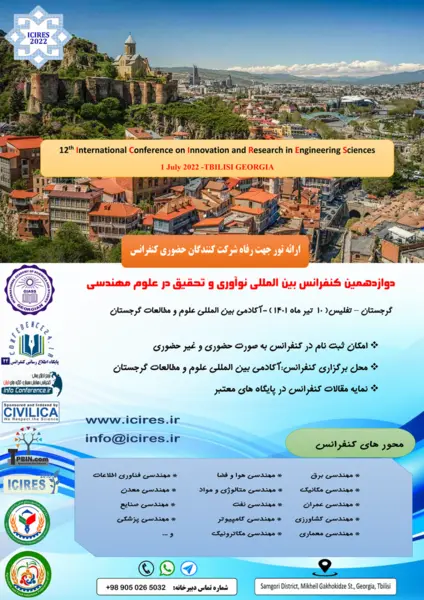-
characterization of al-al3ni composites synthesized in-situ via powder metallurgy method
جزئیات بیشتر مقاله- تاریخ ارائه: 1401/03/31
- تاریخ انتشار در تی پی بین: 1401/06/05
- تعداد بازدید: 179
- تعداد پرسش و پاسخ ها: 0
- شماره تماس دبیرخانه رویداد: 09050265032
characterization of al-al3ni composites synthesized in-situ via powder metallurgy method
al-al3ni composites due to their high strength, creep resistance, fatigue resistance, good ductility, adequate toughness, high corrosion resistance and hardness have gained considerable attention in recent years. in the present investigation, for the first time, powder metallurgy (pm) method was used to in-situ produce al-al3ni composites. commercially pure aluminum powders (63-125 μm) and the same sized pure nickel powders used as starting materials. the al and ni powders were initially soaked in naoh and acetone respectively to remove their surface impurities.
the al/ni powder mixtures with different ni contents subjected to cold pressing and sintering at different temperatures for various times. samples of al powders without ni addition were also prepared using identical procedures as for al/ni composites to serve as the reference samples. the results of xrd, optical microscopy and sem studies as well as brinell hardness measurements performed on the sintered compacts revealed that even after 75 minutes sintering of an al/ni compact at 640 ˚c, the unreacted ni particles could be detected in the sample. the increased sintering temperature to 655˚c resulted in more effective interaction between al and ni during sintering at 15 minutes.
however, sintering at this temperature for longer periods of time resulted in partial melting and deformation of the samples. therefore, ni powders subjected to high-energy ball milling to increase their activity. the xrd results confirmed that sintering at 655˚c of the al/ni powder compact containing 15wt.% of ball-milled ni resulted in complete reaction and al-al3ni eutectic formed without any unreacted ni. the porosity level of the samples increased with increasing percentage of al3ni phase in the matrix.
brinell hardness values of all the composite samples were higher than that of their reference counterpart. the al-20wt.% ni sample prepared by milled ni exhibited the maximum hardness value being almost three times of that of the reference sample. however, the increased content of milled ni to 25wt.% resulted in some unreacted ni particles in the matrix as was confirmed by xrd studies.
مقالات جدیدترین رویدادها
-
استفاده از تحلیل اهمیت-عملکرد در ارائه الگوی مدیریت خلاقیت سازمانی و ارائه راهکار جهت بهبود
-
بررسی تاثیر ارزش وجوه نقد مازاد بر ساختار سرمایه شرکت های پذیرفته شده در بورس اوراق بهادار تهران
-
بررسی تأثیر سطح افشای ریسک بر قرارداد بدهی شرکت های پذیرفته شده در بورس اوراق بهادار تهران
-
بررسی تأثیر رتبه بندی اعتباری مبتنی بر مدل امتیاز بازار نوظهور بر نقد شوندگی سهام با تأکید بر خصوصی سازی شرکت ها
-
تأثیر آمیخته بازاریابی پوشاک ایرانی بر تصویر ذهنی مشتری پوشاک ایرانی (هاکوپیان)
-
ارزیابی روش تحلیل استاتیکی غیرخطی مودی (mpa) در بررسی رفتار لرزه ای قاب های فولادی نیمه صلب با بادبند زانویی
-
بررسی تاثیر استفاده از کامپیوتر در آموزش دانش آموزان
-
ارزیابی گسترش مکانی و زمان شبیه سازی عددی ذرات آلاینده آب مبتنی بر معادله پخش انتشار (مورد مطالعه؛ بندر انزلی)
-
بررسی راهکارهای مختلف الگوسازی بزرگراه ها و ارایه دو راهکار هوشمند مدل سازی بر پایه ویونت
-
تاثیر شناخت الگوی دگردیسی محله بر پایداری کالبدی
مقالات جدیدترین ژورنال ها
-
مدیریت و بررسی افسردگی دانش آموزان دختر مقطع متوسطه دوم در دروان کرونا در شهرستان دزفول
-
مدیریت و بررسی خرد سیاسی در اندیشه ی فردوسی در ادب ایران
-
واکاوی و مدیریت توصیفی قلمدان(جاکلیدی)ضریح در موزه آستان قدس رضوی
-
بررسی تاثیر خلاقیت، دانش و انگیزه کارکنان بر پیشنهادات نوآورانه کارکنان ( مورد مطالعه: هتل های 3 و 4 ستاره استان کرمان)
-
بررسی تاثیر کیفیت سیستم های اطلاعاتی بر تصمیم گیری موفق در شرکتهای تولیدی استان اصفهان (مورد مطالعه: مدیران شرکتهای تولیدی استان اصفهان)
-
اثربخشی درمان مبتنی بر پذیرش و تعهد بر انعطاف پذیری، مهارت های خود مدیریتی و مهارت های تعاملی زنان خیانت دیده مراجعه کننده به مراکز مشاوره بهزیستی شهر اصفهان
-
تاثیر رفتار شهروندی سازمانی بر امنیت سیستم های اطلاعاتی (مطالعه موردی بانک توسعه تعاون)
-
بررسی و شناخت اقسام و ویژگی های المان های شهری
-
اتانازی و احتضار
-
جنبه های حقوقی مسئله رضایت به مداخله نظامی توسط دولت ثالث




سوال خود را در مورد این مقاله مطرح نمایید :